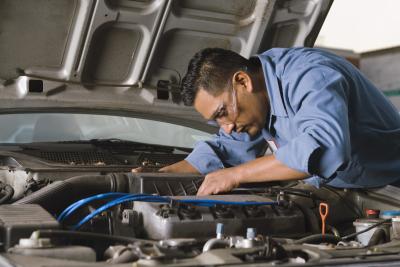
Technology plays a major role inside, outside and all around your car. In the case of diagnosing problems, what once required more than just a few steps and a thick book of diagnostic codes now requires computer skills and the ability to generate a computerized report. Code readers and auto scanners – both common diagnostic tools required for 1996 and newer vehicles -- make determining the source of car problems easier and more accurate. If you are unfamiliar or only slightly familiar with these tools, understanding how they differ can make talking to your mechanic easier and more productive.
It all starts when the “check engine” light on your dashboard blinks or lights up and then remains lit. While you may find it easy to ignore, your vehicle takes immediate, behind-the-scenes action to identify and record the source of the problem within its computer's memory. Retrieving this information requires using either a code reader or auto scanner. Understand, however, that while code readers and auto scanners both have the potential to retrieve one or more trouble codes from computer memory, what makes these tools different is the additional and all-inclusive information auto scanners can provide.
Code readers come in two basic types: On-board Diagnostics I and On-board Diagnostics II -- also called OBD 1 and 2. OBD1 readers can only pull codes from domestic vehicles manufactured between 1981 and 1995, while OBD2 readers focus on domestic, Asian or European passenger cars and light trucks manufactured in or after 1996. While the appropriate reader for your vehicle can pull most generic and manufacturer specific trouble codes, each has limitations that make finding the problem not always possible. Depending on the model, a code reader may display only the trouble code or include a description of the problem along with the code.
An auto scanner has all the capabilities of both OBD1 and OBD2 code readers in one unit as well as additional software features that make finding a specific problem easier. Where a code reader may give you a generic trouble code such as P0038 -- an indication of a problem with your heater control circuit -- it is up to you or your mechanic to determine which of the five possible causes is source of the problem. In contrast, an auto scanner will not only display the trouble code, but also will include features such as flow charts that take a code straight to its source.
The differing capabilities of code readers and auto scanners create other, more obvious difference to you. Price is a major difference, as is the learning curve required to operate an auto scanner compared to a code reader. Although the initial purchase price of a code reader depends on the model, Automotive Specialty Tools reports that, as of the date of this publication, an average price for a code reader is between $35 and $250, while an auto scanner averages between $1,500 and $6,000. In addition, a heavier reliance on technology increases the time it takes to learn to operate an auto scanner.